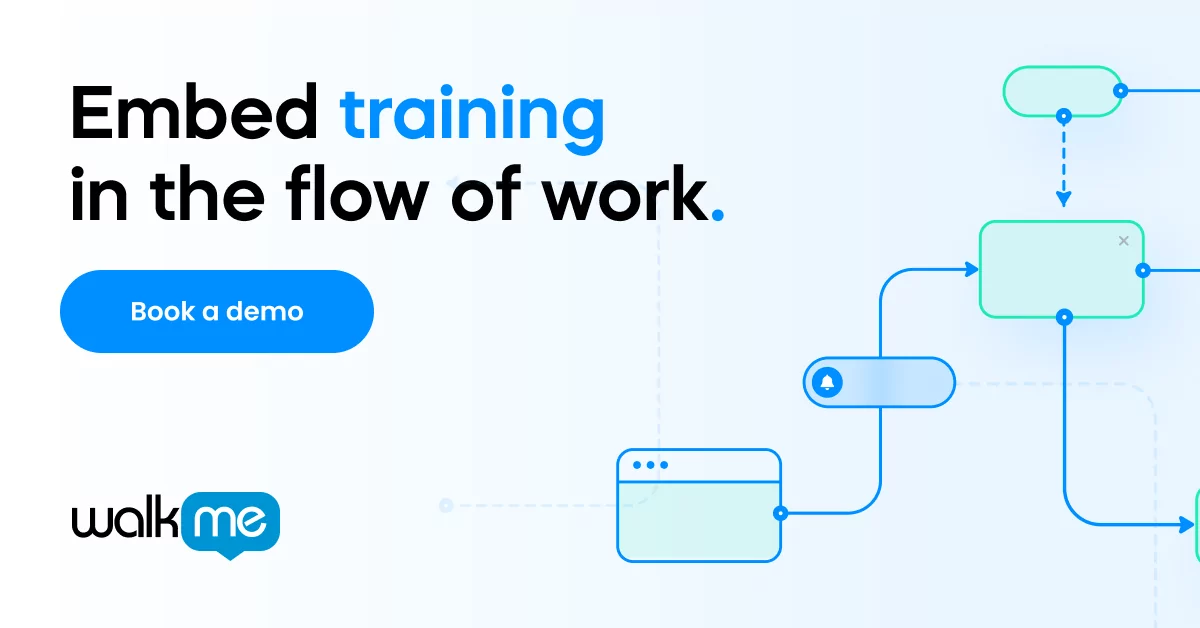Good employee development relies on great employee development plans. An employee development plan gives every worker a clear guide to their progress, with objectives, goals, and strategies to help them succeed. An effective development plan highlights areas for employee training and communicates the information to all stakeholders.
Employee development plans are simple in some ways, but doing them well takes knowledge, skill, and experience. This article will help you create employee development plans that support amazing employee development – a key to organizational performance.
This article will:
- Define an employee development plan – including key features, its role in planning, and alternatives;
- Briefly introduce some employee development plan examples;
- Explain the most important steps to create a good employee development plan;
- Evaluate the most important qualities of an excellent employee development plan.
Development plans are an adaptable way to meet the needs of the workforce today and into the future. In 2023, learning and development professionals are struggling with the skills gap, according to the UK’s CIPD report. It’s a good time to look seriously at your plans and see how you can better support your employee’s growth.
What is an employee development plan?
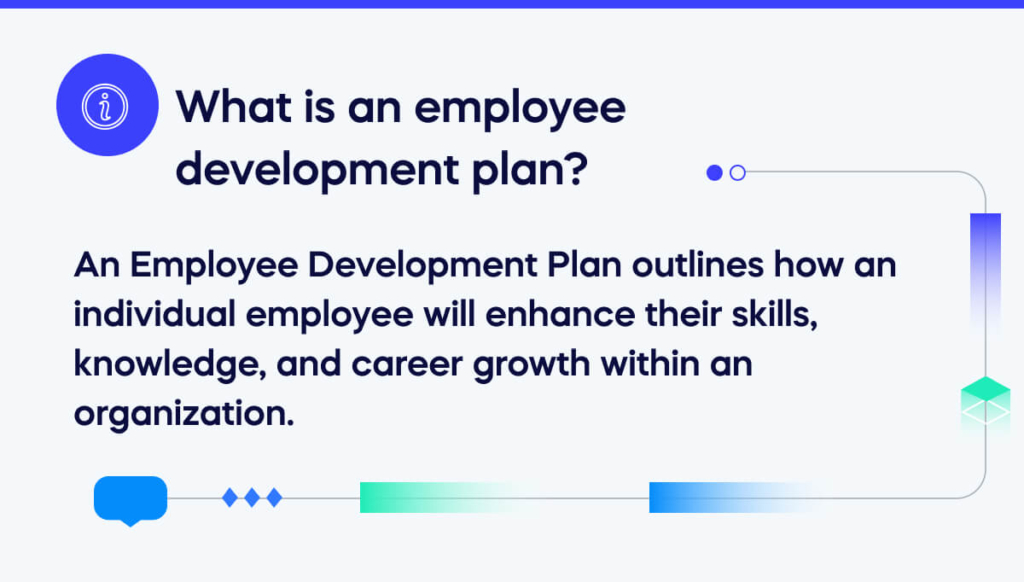
An Employee Development Plan outlines how an individual employee will enhance their skills, knowledge, and career growth within an organization. Although all employees will come into a company with an existing track record of education, performance, and experience, an employee development plan to make sure they continue to grow and develop.
Alternative names include individual development plans, learning and development roadmaps, and personal development programs.
The key features of an employee development plan
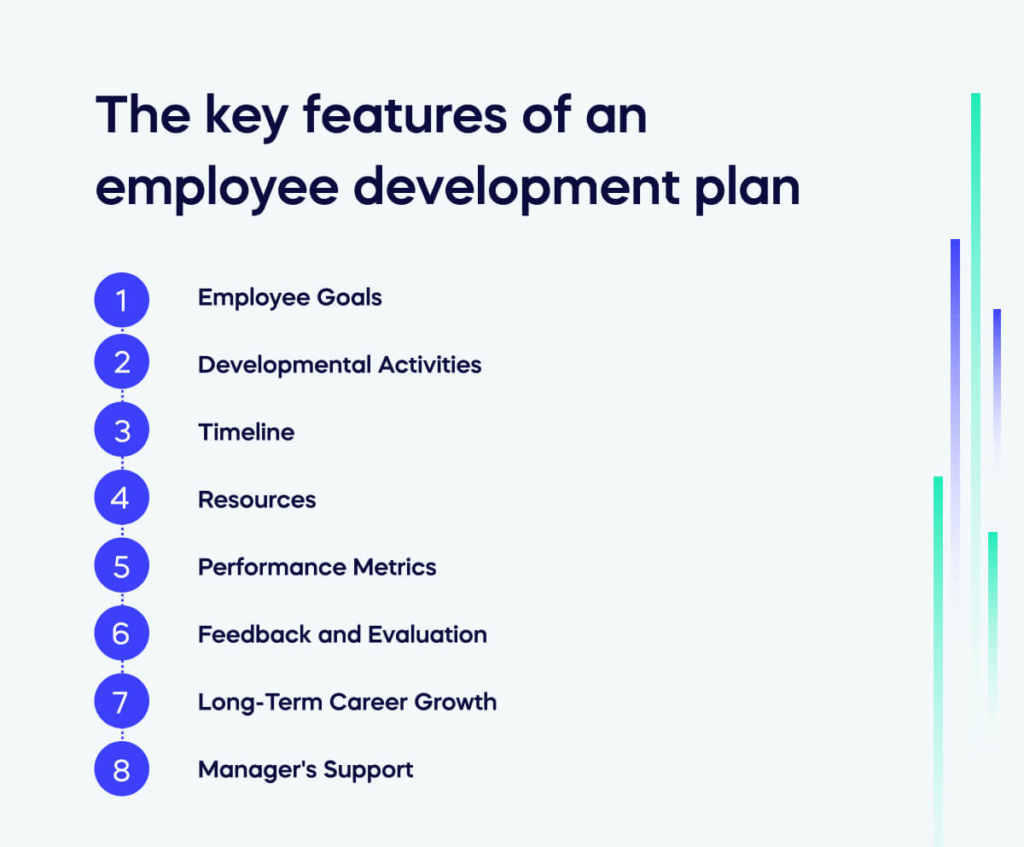
Employee development plans come in many different formats. They will nonetheless have some features in common.
A typical Employee Development Plan is likely to include some (or all) of the following features:
- Employee Goals: Clearly defined objectives or areas for improvement that align with the employee’s career aspirations and the organization’s needs.
- Developmental Activities: Specific actions or training programs will help the employee acquire new skills or knowledge. This can include workshops, courses, mentoring, or on-the-job experiences.
- Timeline: A schedule or timeline outlining when employees should complete each developmental activity or achieve their goals.
- Resources: Any resources, such as books, online courses, or access to certain tools or software, that the employee may need to support their development.
- Performance Metrics: Clear criteria or metrics to measure the employee’s progress and success in achieving their goals.
- Feedback and Evaluation: A plan for regular feedback and evaluations to assess the employee’s development and make any necessary adjustments to the plan.
- Long-Term Career Growth: Consider how the employee’s development plan aligns with their long-term career path within the organization.
- Manager’s Support: The role and responsibilities of the employee’s manager in supporting and guiding their development.
An effective employee development plan is tailored to the individual’s needs and the organization’s objectives, providing a roadmap for continuous growth and improvement.
Employee development plans and employee development programs
Employee development plans serve as a powerful tool for employee development. They offer a structured and goal-oriented approach to personal and professional growth. These plans provide employees with a clear roadmap, specific objectives, and the necessary resources to enhance their skills, knowledge, and capabilities.
Employee development is vital to an organization because it fosters growth, engagement, and adaptability among the workforce.
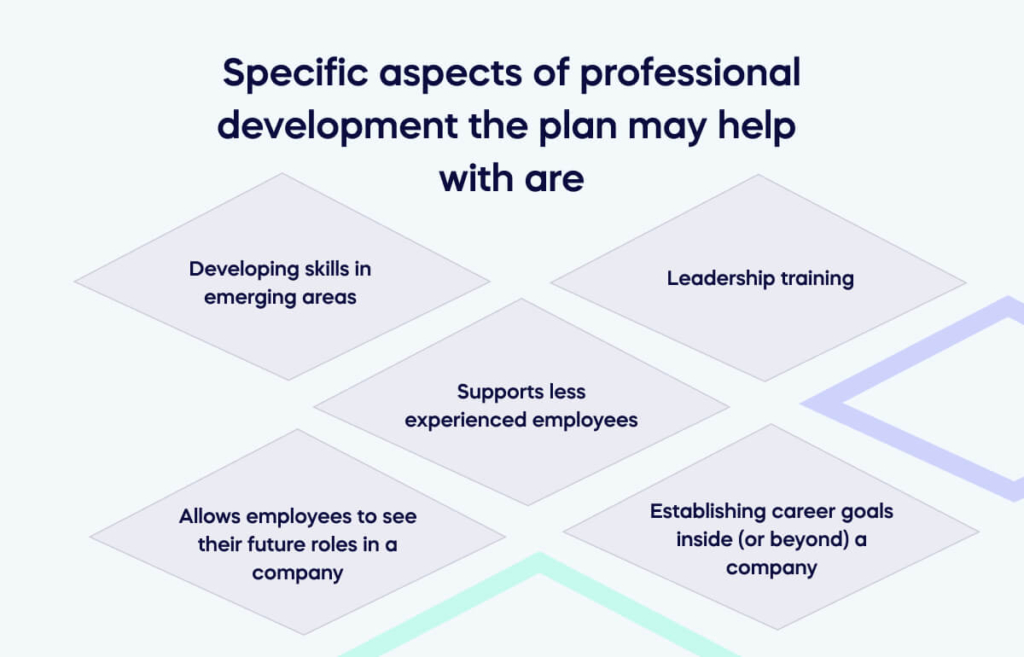
Some of the specific aspects of professional development the plan may help with are:
- Developing skills in emerging areas
- Leadership training
- Supports less experienced employees
- Allows employees to see their future roles in a company
- Establishing career goals inside (or beyond) a company
A commitment to career development plans instills a sense of purpose, motivation, and loyalty among employees, reducing turnover and attracting top talent. Moreover, companies that invest in employees’ skills, knowledge, and career progression are likely to bolster their overall performance.
In an ever-evolving business landscape, employee development is key to maintaining a competitive edge and ensuring long-term success for both individuals and the organization. The employee development plan is a crucial document to ensure effective employee development.
Career development beyond employee development plans
Employee development plans are just one part of a positive system of employee development planning.
Formal plans will only take you so far. They should be just one part of a culture of learning and growth. Regular one-on-one discussions between employees and managers can help to create development goals. Employees should have opportunities for on-the-job learning, cross-functional collaboration, and peer mentoring.
By emphasizing continuous learning and providing a supportive environment, you can nurture employee development effectively without relying solely on formal plans.
Top examples of employee development plans
As we explained above, all employee development plans have some core similarities. However, every different style of planning creates very different outcomes.

If you want to know more, you should check out our article about examples of employee development plans. In brief, some of the main types of plans include:
- Performance-based plan
- Management by objectives
- Ad-Hoc improvement
- Succession planning
Examining employee development plan examples is valuable when creating your own plan because it offers practical insights and inspiration. These examples illustrate different approaches, formats, and elements that have proven successful in various organizations.
They provide a tangible framework and ideas that can be adapted to your specific context and objectives, ensuring that your employee development plan is well-structured, effective, and tailored to the needs of your employees and organization.
5 steps to craft your employee development plan
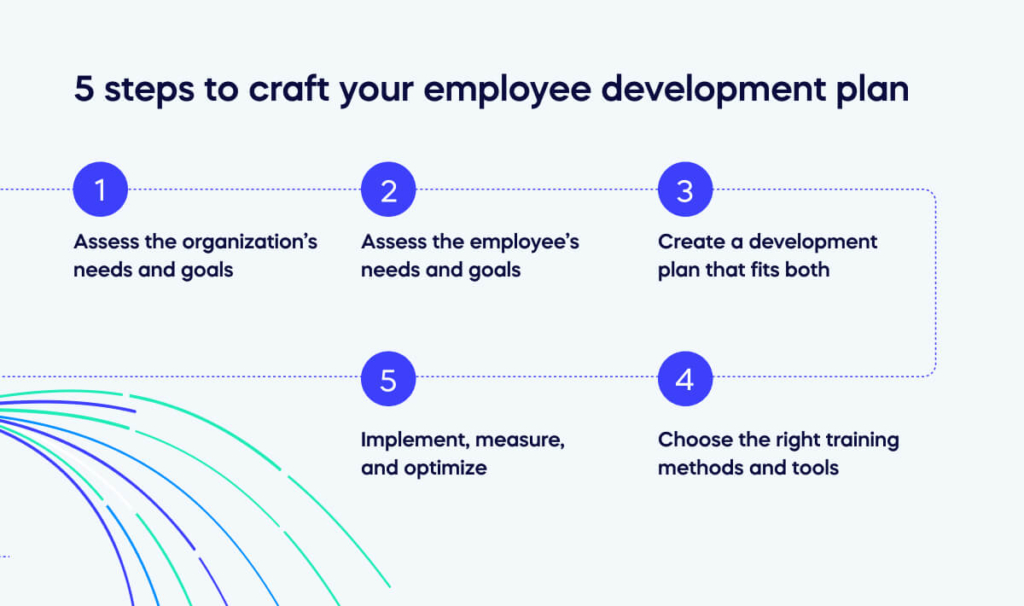
Once you know how to do it, creating an employee development plan is relatively straightforward. Having a clear set of methodologies and protocols is important so anyone can successfully create and supervise employee development programs.
In this section, we will look at five key steps that will support every employee development plan. This should help you to create your plans. If you’ve got time, look at our other resources on the performance management process to get a bigger perspective on the topic.
1. Assess the organization’s needs and goals
Since employee development puts organizations’ needs first, those needs should be prioritized.
It pays to consider:
- The current needs of the organization
- Impending organizational changes and digital transformation programs
- What the organization will need in the near and long-term future
These needs will be used to establish the limits of the employee development plan and discover how employees can best meet them.
During this phase of planning, foresight is key.
Many companies are undergoing continual organizational change and digital transformation, so development plans should consider those changes. Those in charge of employee development planning should collaborate with business leaders and others aware of those changes to ensure that employee development plans are properly aligned.
2. Assess the employee’s needs and goals
Every employee is different, and each will have a unique set of:
- Strengths
- Weaknesses
- Skills
- Goals
Ideally, employee development plans should simultaneously meet employees’ and the organization’s aims.
3. Create a development plan that fits both
If development programs focus on the organization’s goals over the employee goals, then the content will be less relevant and can cause workers to disengage. However, if those plans prioritize employee development over the organization’s goals, then what’s really being created is a career development plan, not an employee development plan.
As mentioned, the distinction does matter, and if an organization needs to prioritize its own goals, then the plan’s emphasis should be shifted.
Ultimately, to maximize engagement and profitability, an employee development plan should strive to satisfy the agendas of each party.
4. Choose the right training methods and tools
Earlier, we looked at four examples of employee development plans and how each can improve employee productivity and engagement.
Each type of plan has its own strengths and weaknesses. Succession planning and mentorship programs, for instance, can be useful for career-driven plans that provide experience-based knowledge to employees. However, these types of programs cannot impart certain types of knowledge.
For instance, An organization undergoing disruptive change may elect to emphasize the need for cutting-edge digital skills. Succession planning may still be useful in certain respects, but it is not an effective way to train workers on new digital tools.
For organizations with aggressive digital transformation agendas, it is better to follow a different plan emphasizing digital adoption and training.
5. Implement, measure, and optimize
As with other business processes, employee development plans should be tested and optimized over time.
Employee surveys, one-on-one discussions, performance metrics, and manager feedback can all be useful data sources. These can be used to improve the effectiveness and adjust the trajectory of a given employee development plan and are useful for enhancing future employee development efforts.
Another option is to engage in ad-hoc planning, as mentioned above, which tends to be more incremental and flexible in nature. Since they are only delivered as needed, they are easy to implement and change at will.
The top features of a good employee development plan
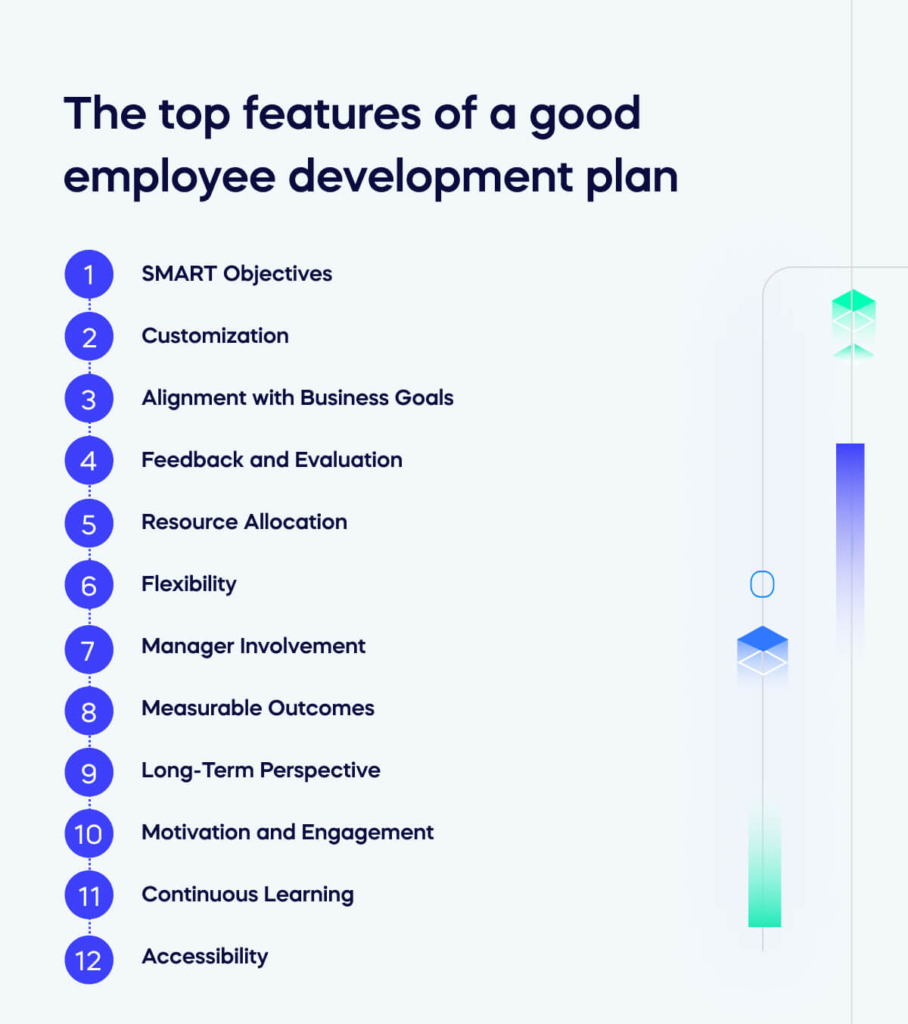
After creating a plan, how do you know it will work effectively? Everyone needs clear success criteria for their plans – new employees especially!
Our top qualities to look out for include:
- SMART Objectives: Goals within the plan should be Specific, Measurable, Achievable, Relevant, and Time-bound, providing clear direction and criteria for success.
- Customization: The plan should be tailored to the individual employee’s needs, considering their current skills, career aspirations, and the organization’s goals.
- Alignment with Business Goals: Development objectives should align with the broader objectives and strategies of the organization to ensure that employee growth contributes to the company’s success.
- Feedback and Evaluation: There should be mechanisms in place for regular feedback, progress tracking, and evaluation to ensure that development efforts are on track and effective.
- Resource Allocation: Adequate resources, such as time, budget, and access to training materials, should be allocated to support the employee’s development journey.
- Flexibility: The plan should allow for adjustments as the employee’s needs or business priorities change.
- Manager Involvement: Managers should play an active role in guiding, coaching, and supporting the employee’s development, providing valuable insights and mentoring.
- Measurable Outcomes: The plan should define clear, quantifiable outcomes and milestones to measure progress and success.
- Long-Term Perspective: It should consider the employee’s long-term career growth, not just short-term skill acquisition.
- Motivation and Engagement: The plan should motivate and engage employees by aligning development efforts with their interests and aspirations, fostering a sense of purpose and commitment.
- Continuous Learning: It should promote a culture of constant learning and development within the organization.
- Accessibility: Learning resources and opportunities should be easily accessible to employees, whether through internal programs, external courses, or digital platforms.
Make employee development a cornerstone of company culture
If you’re not convinced about the importance of employee development programs, a March 2023 analysis from McKinsey puts things very clearly: “A reputation for a strong culture of people development can make all the difference for companies in a tight labor market.”
Employee retention is a very important issue in 2023 for anyone trying to achieve their company goals. In this context, making great plans can be very rewarding to achieve job satisfaction for all your employees.
